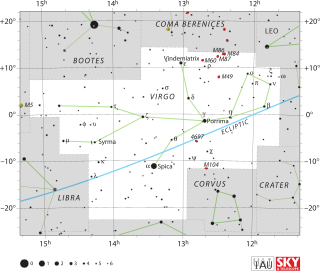
Virgo is one of the constellations of the zodiac. Its name is Latin for maiden, and its old astronomical symbol is . Between Leo to the west and Libra to the east, it is the second-largest constellation in the sky and the largest constellation in the zodiac. The ecliptic intersects the celestial equator within this constellation and Pisces. Underlying these technical two definitions, the sun passes directly overhead of the equator, within this constellation, at the September equinox. Virgo can be easily found through its brightest star, Spica.
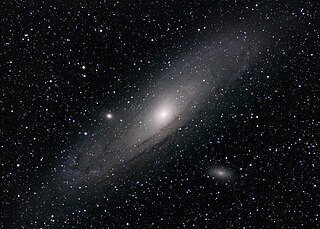
The Andromeda Galaxy is a barred spiral galaxy and is the nearest major galaxy to the Milky Way. It was originally named the Andromeda Nebula and is cataloged as Messier 31, M31, and NGC 224. Andromeda has a diameter of about 46.56 kiloparsecs and is approximately 765 kpc from Earth. The galaxy's name stems from the area of Earth's sky in which it appears, the constellation of Andromeda, which itself is named after the princess who was the wife of Perseus in Greek mythology.
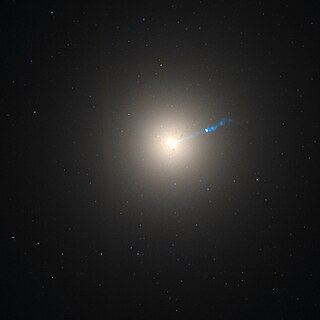
An elliptical galaxy is a type of galaxy with an approximately ellipsoidal shape and a smooth, nearly featureless image. They are one of the four main classes of galaxy described by Edwin Hubble in his Hubble sequence and 1936 work The Realm of the Nebulae, along with spiral and lenticular galaxies. Elliptical (E) galaxies are, together with lenticular galaxies (S0) with their large-scale disks, and ES galaxies with their intermediate scale disks, a subset of the "early-type" galaxy population.
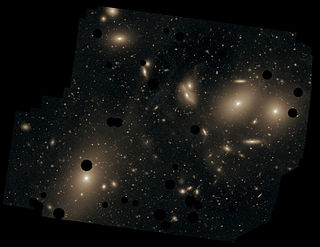
The Virgo Cluster is a large cluster of galaxies whose center is 53.8 ± 0.3 Mly away in the constellation Virgo. Comprising approximately 1,300 member galaxies, the cluster forms the heart of the larger Virgo Supercluster, of which the Local Group is a member. The Local Group actually experiences the mass of the Virgo Supercluster as the Virgocentric flow. It is estimated that the Virgo Cluster's mass is 1.2×1015M☉ out to 8 degrees of the cluster's center or a radius of about 2.2 Mpc.

Messier 87 is a supergiant elliptical galaxy in the constellation Virgo that contains several trillion stars. One of the largest and most massive galaxies in the local universe, it has a large population of globular clusters—about 15,000 compared with the 150–200 orbiting the Milky Way—and a jet of energetic plasma that originates at the core and extends at least 1,500 parsecs, traveling at a relativistic speed. It is one of the brightest radio sources in the sky and a popular target for both amateur and professional astronomers.

A dwarf galaxy is a small galaxy composed of about 1000 up to several billion stars, as compared to the Milky Way's 200–400 billion stars. The Large Magellanic Cloud, which closely orbits the Milky Way and contains over 30 billion stars, is sometimes classified as a dwarf galaxy; others consider it a full-fledged galaxy. Dwarf galaxies' formation and activity are thought to be heavily influenced by interactions with larger galaxies. Astronomers identify numerous types of dwarf galaxies, based on their shape and composition.

Messier 85 is a lenticular galaxy, or elliptical galaxy for other authors, in the Coma Berenices constellation. It is 60 million light-years away, and it is estimated to be 125,000 light-years across.

Messier 89 is an elliptical galaxy in the constellation Virgo. It was discovered by Charles Messier on March 18, 1781. M89 is a member of the Virgo Cluster of galaxies.
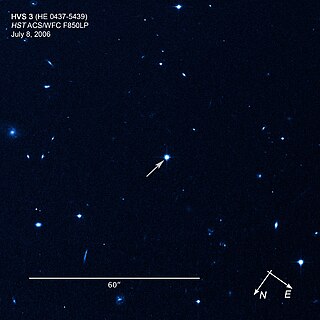
HE 0437-5439 is a massive, unbound hypervelocity star (HVS), also called HVS3. It is a main sequence B-type star located in the Dorado constellation. It was discovered in 2005 with the Kueyen 8.2-metre (320 in) telescope, which is part of the European Southern Observatory's Very Large Telescope array. HE 0437-5439 is a young star, with an age of around 30 million years. The mass of the star is almost nine times greater than the mass of the Sun and the star is located 200,000 light years away in the direction of the Dorado constellation, 16 degrees northwest of the Large Magellanic Cloud (LMC) and farther away than the LMC. The star appears to be receding at an extremely high velocity of 723 kilometres per second (449 mi/s), or 2,600,000 kilometres per hour (1,600,000 mph). At this speed, the star is no longer gravitationally bound and will leave the Milky Way galaxy system and escape into intergalactic space. It was thought to have originated in the LMC and been ejected from it soon after birth. This could happen if it originally was one of a pair of stars and if there is a supermassive black hole in the LMC.
A pulsar kick is the name of the phenomenon that often causes a neutron star to move with a different, usually substantially greater, velocity than its progenitor star. The cause of pulsar kicks is unknown, but many astrophysicists believe that it must be due to an asymmetry in the way a supernova explodes. If true, this would give information about the supernova mechanism.

NGC 5170 is a large, nearby, edge-on spiral galaxy in the equatorial constellation of Virgo. It was discovered on February 7, 1785 by William Herschel. This galaxy is located at a distance of 83.5 million light years and is receding at a heliocentric radial velocity of 1,502 km/s. It is a member of the Virgo II Groups, a series of galaxies and galaxy clusters strung out from the southern edge of the Virgo Supercluster.

In astronomy, stellar kinematics is the observational study or measurement of the kinematics or motions of stars through space.
A hypercompact stellar system (HCSS) is a dense cluster of stars around a supermassive black hole that has been ejected from the center of its host galaxy. Stars that are close to the black hole at the time of the ejection will remain bound to the black hole after it leaves the galaxy, forming the HCSS.

An intergalactic star, also known as an intracluster star or a rogue star, is a star not gravitationally bound to any galaxy. Although a source of much discussion in the scientific community during the late 1990s, intergalactic stars are now generally thought to have originated in galaxies, like other stars, before being expelled as the result of either galaxies colliding or of a multiple-star system traveling too close to a supermassive black hole, which are found at the center of many galaxies.
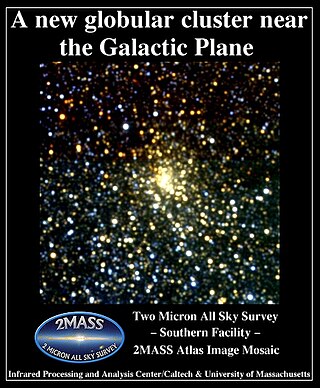
2MASS-GC02, also known as Hurt 2, is a globular cluster at a distance of about 16 thousand light-years from Earth in the constellation Sagittarius. It was discovered in 2000 by Joselino Vasquez together with globular cluster 2MASS-GC01 and a spiral galaxy 2MASXI J0730080-220105, and confirmed by a team of astronomers under the leadership of R. J. Hurt at 2MASS.

NGC 1399 is a large elliptical galaxy in the Southern constellation Fornax, the central galaxy in the Fornax Cluster. The galaxy is 66 million light-years away from Earth. With a diameter of 130 000 light-years, it is one of the largest galaxies in the Fornax Cluster and slightly larger than the Milky Way. William Herschel discovered this galaxy on October 22, 1835.
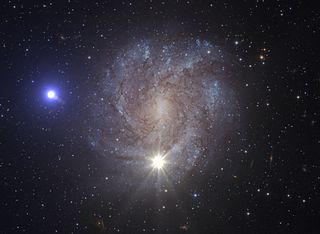
US 708 is a hyper-velocity O class subdwarf in Ursa Major in the halo of the Milky Way Galaxy. One of the fastest-moving stars in the galaxy, the star was first surveyed in 1982.
The Eridanus II Dwarf is a low-surface brightness dwarf galaxy in the constellation Eridanus. Eridanus II was independently discovered by two groups in 2015, using data from the Dark Energy Survey. This galaxy is probably a distant satellite of the Milky Way. Li et al., 2016. Eridanus II contains a centrally located globular cluster; and is the smallest, least luminous galaxy known to contain a globular cluster. Crnojević et al., 2016. Eridanus II is significant, in a general sense, because the widely accepted Lambda CDM cosmology predicts the existence of many more dwarf galaxies than have yet been observed. The search for just such bodies was one of the motivations for the ongoing Dark Energy Survey observations. Eridanus II has special significance because of its apparently stable globular cluster. The stability of this cluster, near the center of such a small, diffuse, galaxy places constraints on the nature of dark matter. Brandt 2016.

NGC 4237 is a flocculent spiral galaxy located about 60 million light-years away in the constellation Coma Berenices. The galaxy was discovered by astronomer William Herschel on December 30, 1783 and is a member of the Virgo Cluster. It is also classified as a LINER galaxy and as a Seyfert galaxy.

NGC 4636 is an elliptical galaxy located in the constellation Virgo. It is a member of the NGC 4753 Group of galaxies, which is a member of the Virgo II Groups, a series of galaxies and galaxy clusters strung out from the southern edge of the Virgo Supercluster. It is located at a distance of about 55 million light years from Earth, which, given its apparent dimensions, means that NGC 4636 is about 105,000 light years across.
















